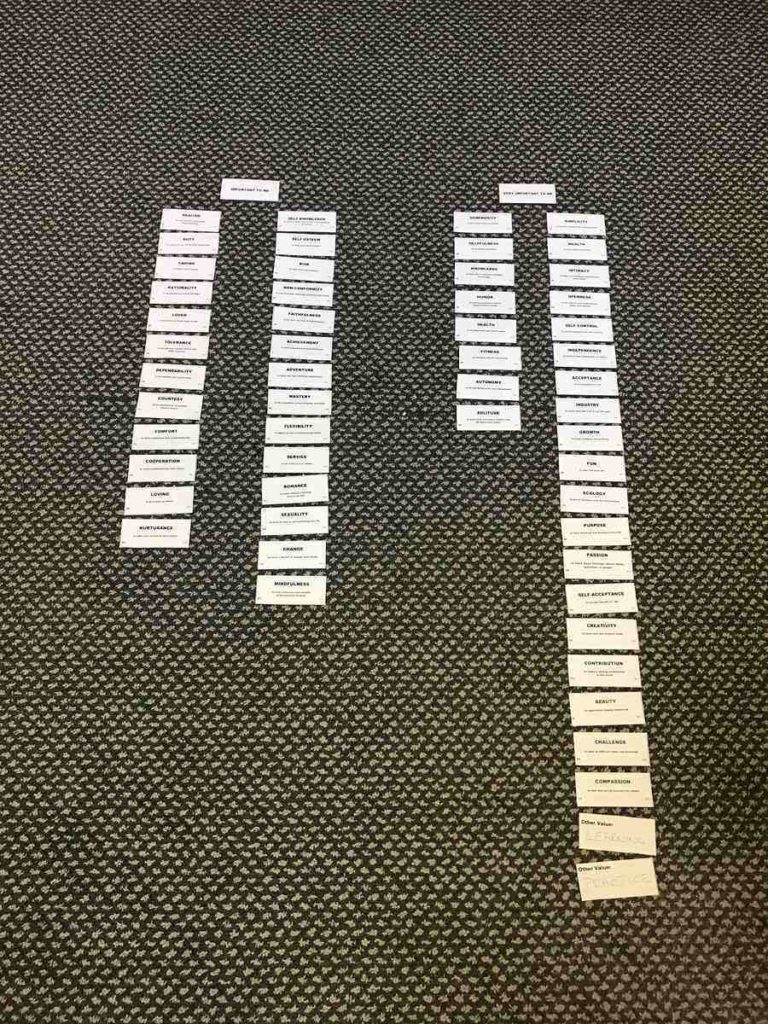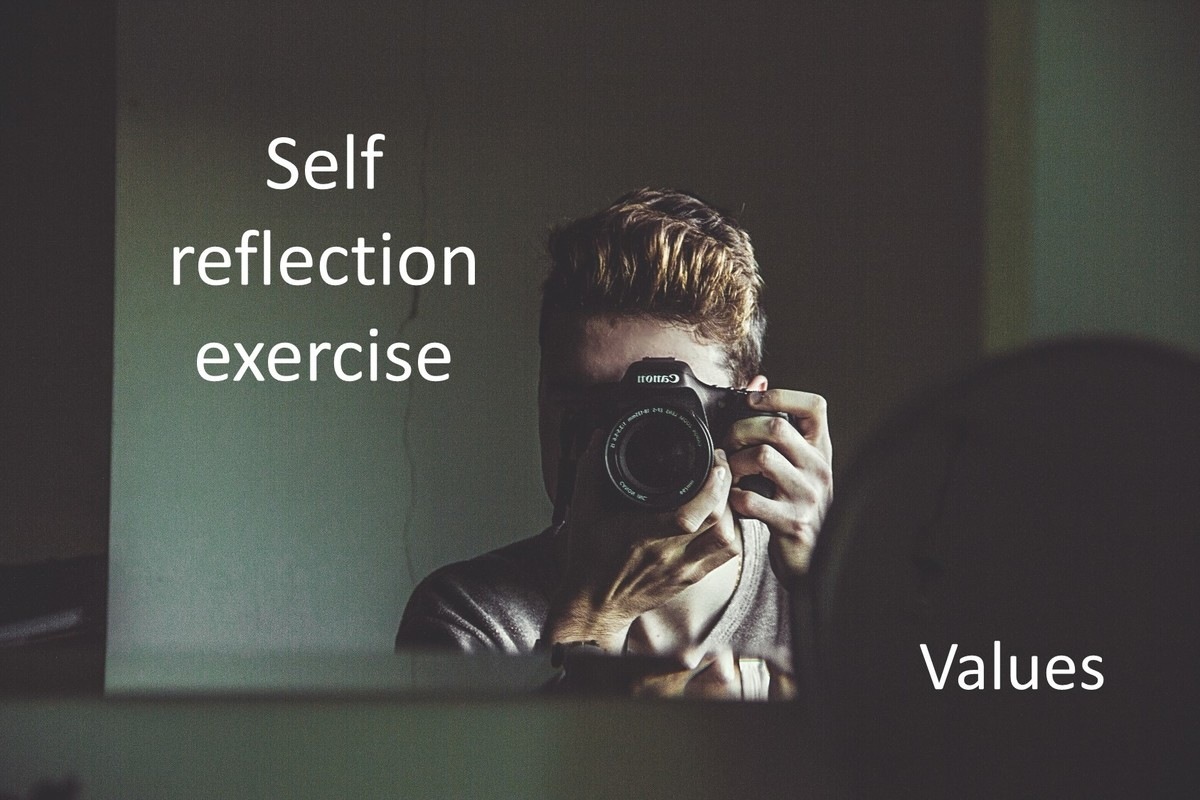
Hello there internet person!
I’ve been meaning to write a post like this for years. Learning about values in my counselling and therapy training had a significant impact on me. I find values work interesting, rewarding, challenging and illuminating.
Values work is common in counselling and therapy, and is a component of a number of models of therapy (e.g. Acceptance and Commitment Therapy, Motivational Interviewing).
What are values?
Values are descriptions of the type of person you want to be and how you want to live your life. They are the words that we hope people use to describe us when we have passed – “He was loving, industrious and compassionate”.
Our values guide our choices in life, help us make decisions, and help keep us grounded during times of great emotional intensity. When we set goals in life, those that are consistent with our values will be the ones that are most rewarding to achieve.
I’ve found a map analogy to be useful in understanding values. Say you are looking at a map and seeing destinations on that map (e.g. towns, cities). Those destinations are like goals, they are specific places that we can get to, and we know when we have got there. Values however are like the compass directions – north, south, east, west. We know if are moving in the right direction, but we never actually achieve “north”.
Why focus on values?
Our choices in life are dictated by many things: preferences, values, opportunity, other people’s expectations, society’s expectations, availability, tradition.
It’s easy to get to a point where you are living a life, but it doesn’t really feel like a rewarding life or one that you personally want to live. You might also find yourself at a decision point in your life (e.g. leaving school, selecting university courses) and are not sure what direction to take. Taking the time to reflect on your values at these times can help you make key decisions about where you want to go in your life or pick between different options.
Values work can also help ground us during times of distress. For example, the university experience can be challenging at times. Reminding ourselves that we took on our course because of a love of learning, or an opportunity to express our creativity can help us accept periods of intermittent distress as we live those values.
Values work is helpful when we feel stuck in some aspect of our life; emotionally, occupationally, personally. It might identify areas in our life where we are not living according to our values and are distressed as a result. For example, working in a job with low autonomy when in fact we really enjoy working alone.
How to do some values work on your own
The method described below is by no means the only way to engage in some self-reflective values work. A Google search on “values and therapy” will find you a number of tools and exercises that you can do. The method described below is however simple to do, and (in my experience of doing it) very thought provoking.
What you’ll need
Some paper and a printer – to print out the attached values cards
Some scissors – to cut out the individual cards
Some floor or table space
A stapler or paper clips
20-30 minutes of time
Instructions
1) Print out the attached values card sheets. Remember to print 1-sided as you will be cutting out each individual card.
2) Take the scissors and cut out each individual card. I’d suggest putting on some music and pretending you are back in primary school where cutting out was actually a skill.
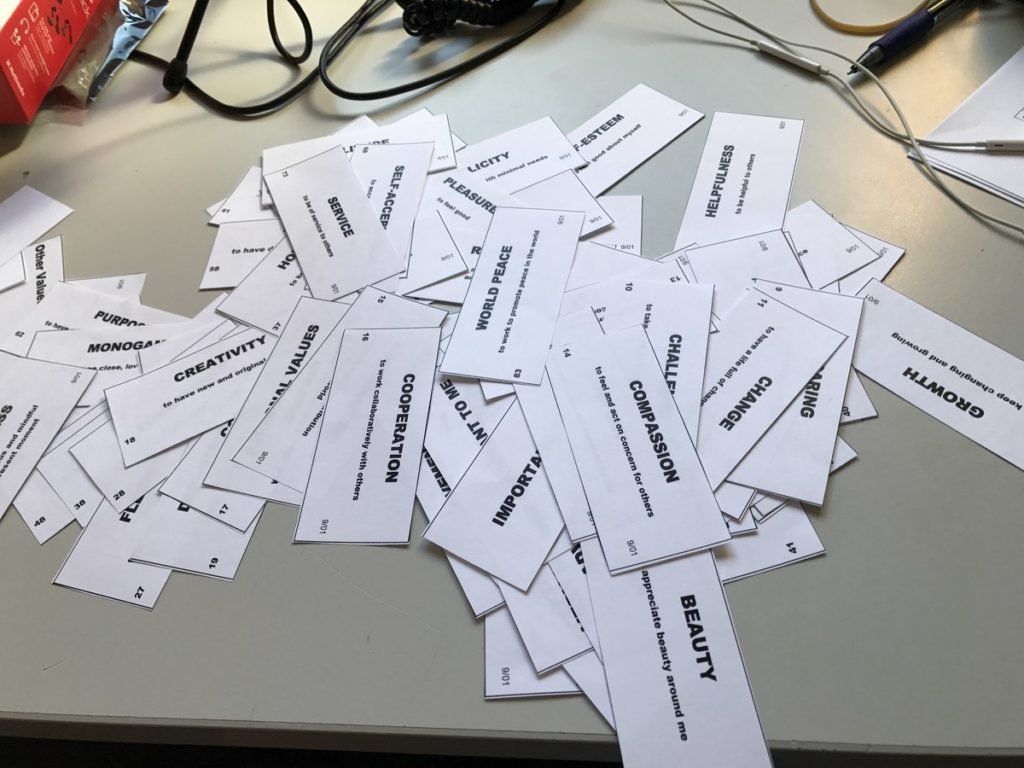
3) Separate out the “not important to me”, “important to me”, and “very important to me” to me cards from the rest of the values cards. Place these left to right on some floor or desk space as headings. Also separate out the “other value” cards.
4) With just the values cards in your hand, review them, one-at-a-time and place them under the most appropriate heading for you. Don’t overthink each card, just go with your initial gut response. Remember that you are rating each value in terms of how important it is to YOU. It can be easy to start focusing on what you think other people expect you to be and lose sight of your own values.
So if this has gone to plan, you should now have something a bit like this, with the values cards sorted under the headings of “not important to me”, “important to me”, and “very important to me”. Don’t worry if the numbers of cards under each heading is different to the photo.
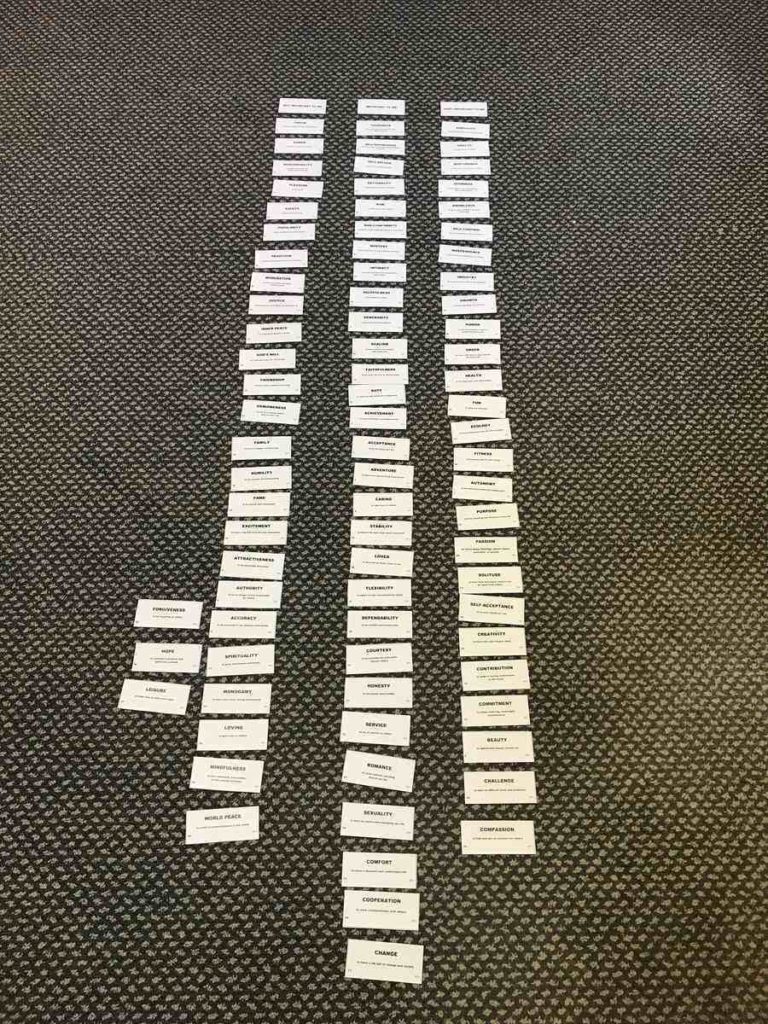
Also, if there are values that were not on any of the cards, feel free to the use “other value” cards to create them. I added “learning” and “practice” to the “very important to me” pile as I wish to always be learning new things and practice those skills that are important to me (e.g. guitar).
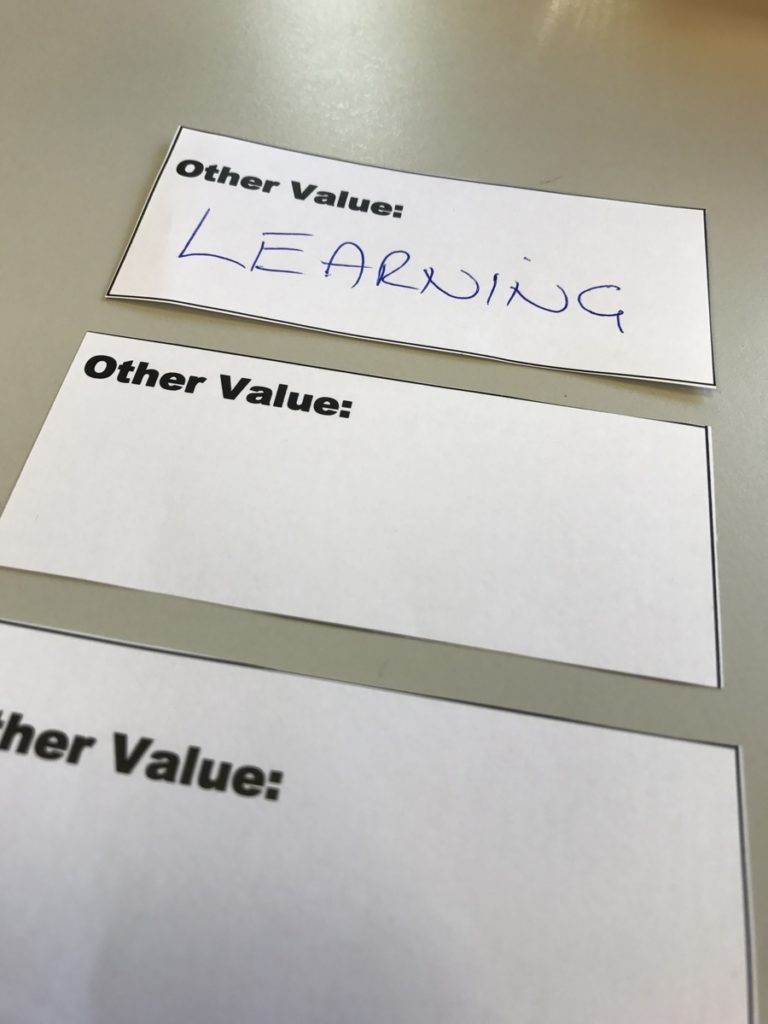
In the next couple of steps we are going to focus on the “not important to me” pile.
5) Quickly review each value in the “not important to me” pile to just check that they are indeed not important to you. Sometimes we put some values in the “not important to me” pile because we are avoiding them, when if we were honest with ourselves, we’d actually say it was quite important. Move any that are “important” or “very important” into the relevant piles.
6) Pack up the “not important to me” pile and put to the side. You will not have to work with these again (at least not in this exercise).
Now we are going to spend some time with the “important to me” and “very important to me piles. Essentially you are going to review the values in each of these piles twice.
7) In the first run through, ask yourself whether a particular value belongs in that pile. You might find yourself swapping values between the “important” and “very important” piles, or perhaps even removing them to the “not important to me” pile.
When I did this part, I experienced a few things:
- For some values its really hard to work out whether they are “important” or “very important” – i just tried to make decisions quickly and not spend too long thinking about any individual value.
- Some of the values I put in the important pile, I put there because I thought I should (i.e. its socially acceptable). Upon further reflection, I removed a few to the “not important to me” pile.
- I found my important and very important piles to be quite big. At first I was concerned, but there aren’t really any rules about how many should be in each pile.
- There were a few values (e.g. wealth) that I felt a bit guilty admitting were important to me. It’s important however to be honest in this process. You can do this process alone and not have to share the outcomes with anyone.
8) So having clarified which values sit in which pile, in the second go through, you are going to divide each pile into two groups (i.e. you will do this process with both the “important to me” and “very important to me” piles).
The first group is what I call the “I reckon I am living these values pretty well” group. Put values in here that you think you are living pretty well. For example, I put cooperation and courtesy in this pile as I think I generally try to be cooperative and courteous in my daily life.
The second group is what I call the “I probably need to be reminded of these values” group. These are the values that are important to you, but you could probably use some reminding of at times. For example I put ‘beauty’ (appreciate beauty around me) in this group, because I feel I need to remind myself to take time to appreciate beauty (especially nature) each day.
If you completed this process with both the “important to me” and “very important to me” piles, you should have four piles, a bit like this:
9) I then combined the two “I reckon I am living these values pretty well” groups and the two “I probably need to be reminded of these values” groups, with the very important ones stacked on top of the important ones. This gave me two piles. I stapled or clipped them together.
10) I labelled the “I reckon I am living these values pretty well” pile as THIS IS ME. I thought this would be a good set to look at when I feeling a bit down, maybe as a reminder of the person I feel I have good at being.
I labelled the “I probably need to be reminded of these values” as THIS IS WHO I AM WORKING TOWARDS. I thought this would be a good pile to carry around with me for a couple of weeks and think about what I might do to live these values more completely.
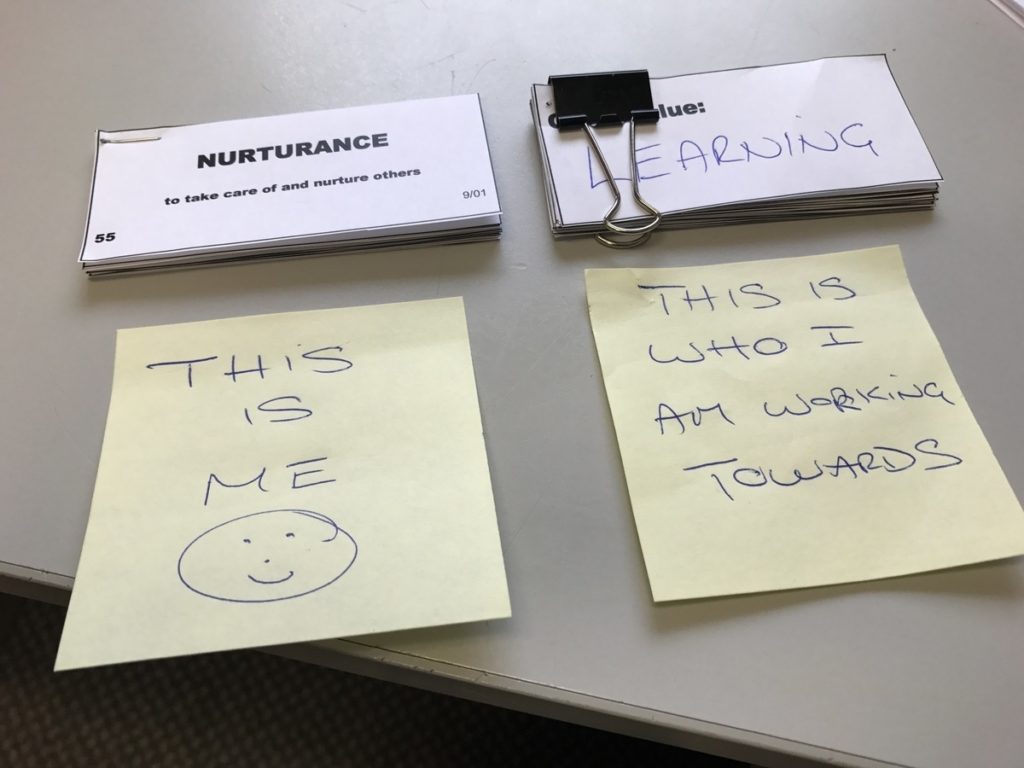
What next?
Well this is a little dependent on how the exercise turned out for you.
For me, it was a generally positive experience. There were plenty of values that I didn’t think I was living fully, but I could see some ways that I could address each of these. For example, I feel like I am not opening myself up to enough new learning experiences, but knew of a few courses (gardening related) that I could book in the coming months. In fact, a simple extension to this exercise is to take each of the values in the THIS IS WHO I AM WORKING TOWARDS pile and come up with simple short-term goals/tasks you could put in place to trying living these values more fully.
For some people who have big decisions to make, this exercise can assist in this process by helping them weigh up each of their options in terms of how consistent they are with their values. For example, the selection of which subjects or courses to do might be made easier by considering the possible career options down the track, and how consistent they are with you values.
For others however this process can be a bit confronting. There might be important values that an individual feels they are not fully living, or values they feel they are living the opposite. In these cases, the exercise might raise negative feelings: shame, guilt, sadness. If so, consider sharing the results with a friend, family member or professional. It might be that you need to spend a little more time discussing these issues before getting positive impacts from an exercise like this.
Finally for some people the exercise is pretty neutral. It’s intellectually interesting to think about who you want to be, but its not particularly moving in either a positive or negative direction. Perhaps it was the wrong time in your life to do the exercise. Perhaps you are in a good place at the moment.
It is the kind of exercise I recommend doing on a semi-regular basis (e.g. once a year) as our lives and values shift depending on our experiences. Its also the kind of exercise I recommend doing during important transition periods (e.g. changing jobs, starting a family).
Feedback
Did you try the exercise?
Was it interesting, useless, poorly explained, life-changing?
Let me know, and also whether you are interested in similar self reflection exercises in the future.
Want to comment on this article, or ask me a question about the health and well-being services available to you as a student? Feel free to comment below, abuse me on Twitter (@Dr_Furber), contact me on Skype (search for ‘eMental Health Project Officer Gareth’), or email me (gareth.furber@flinders.edu.au)


